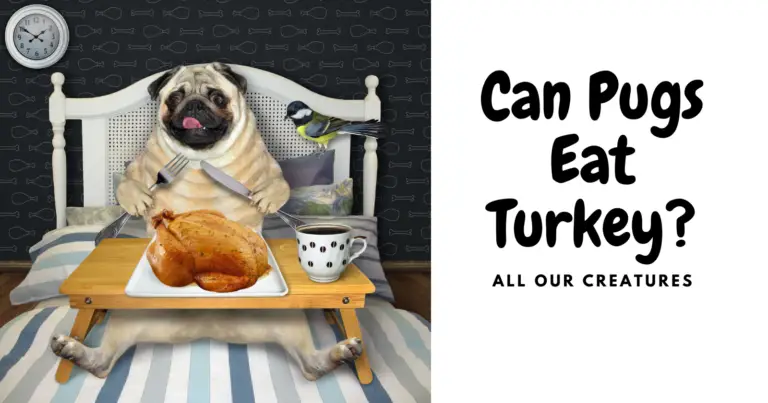Can Pugs Eat Raw Meat? Expert Guidance on Their Diet
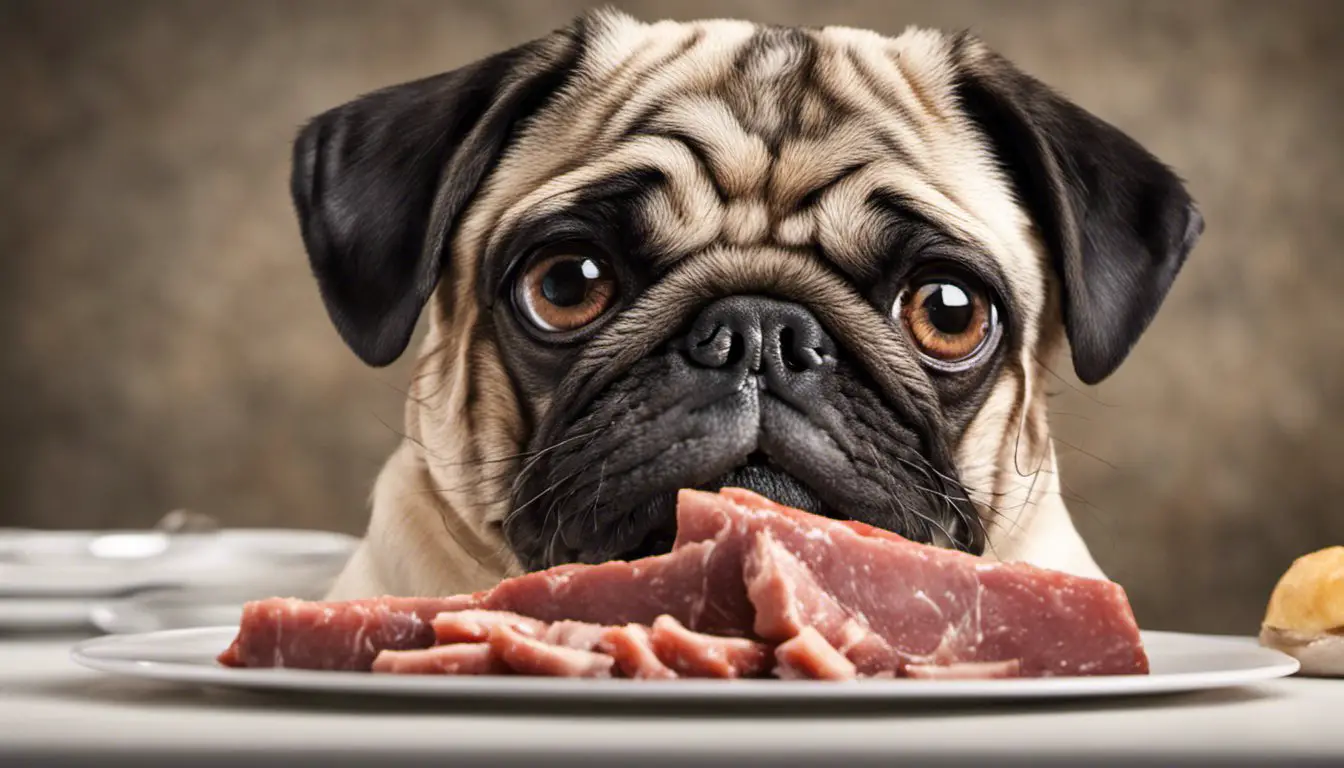
Many dog owners have embraced raw meat diets for their pets, and you might wonder if this approach suits your pug. Can Pugs Eat Raw Meat? Raw meat diets can offer various health benefits for dogs, but it is important to ensure that you are tailoring this diet to your pug’s specific needs to support their overall well-being.

Pugs, like any other dog breed, can eat raw meat. However, you need to consider some considerations when feeding your Pug a raw diet. You should balance raw meat with other essential nutrients like fruits, vegetables, and raw meaty bones to provide a well-rounded meal that caters to your pug’s dietary requirements.
Following guidelines when preparing raw meals for your pug is crucial, as proper planning will help you avoid potential issues like choking hazards or nutritional imbalances. By designing a diet that meets your pug’s needs, you can help ensure that your furry friend enjoys all the benefits of a raw meat diet while staying happy and healthy.
Contents
Table of Contents
Understanding a Pug’s Diet

As a pug owner, it’s essential to know that their dietary needs can be different compared to other dog breeds. Pugs require specific nutrients for their unique bodies to function optimally. Providing a balanced diet for your pug will ensure their health and well-being.
Get The Free Food Eating Guide That Keeps My Pug Happy and Playful Even at 13 Years Old
100% Beginner Friendly & Lists Real Foods Your Pug Can Actually Eat!

It is crucial to understand that pugs can eat a raw diet; in fact, it can offer numerous health benefits for them. When incorporating raw meat into your pug’s diet, you must follow certain guidelines to tailor the raw diet from the provided sources to make it suitable for your pet.
While preparing a raw diet for your pug, ensure you include:
- Protein-rich sources, such as meat, poultry, and fish
- Fresh vegetables and fruits
- Small amounts of whole grains
It’s highly recommended to avoid giving your pug foods that other breeds might tolerate but may cause issues for your pug. Some examples include chocolate, grapes, and onions. Be mindful of providing foods suitable for pugs to prevent any harmful effects.
When determining portion sizes for your pug, pay close attention to their size, age, and activity level. These factors will help you provide the appropriate amount of calories and nutrients to maintain your pug’s overall health. If unsure how much to feed your pug, consult your veterinarian.
Ultimately, the key to a healthy diet for your pug lies in providing the appropriate balance of nutrients, including proteins, carbohydrates, fats, and vitamins. Monitor your pug’s weight, energy levels, and overall well-being to ensure the diet meets their needs. Don’t hesitate to make adjustments as needed or seek professional advice for your pug’s optimal health.
The Raw Food Diet for Dogs: An Overview
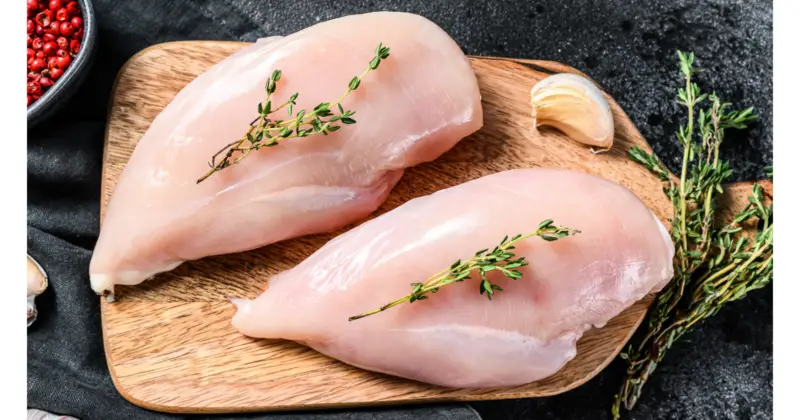
A raw food diet for dogs consists of uncooked animal products such as muscle meat, whole or crushed bones, organ meats, and raw eggs. This type of diet aims to simulate the natural, ancestral diet of your dog’s wild counterparts. As a dog owner, you might consider this dietary option for your Pug, as it has recently gained popularity.
When choosing a raw diet for your Pug, there are two primary approaches: the Biologically Appropriate Raw Food (BARF) diet and the Prey Model Raw (PMR) diet. Although they may seem similar, there are key differences to consider.
The BARF diet includes both animal and plant-based foods, such as fruits, vegetables, and sometimes dairy products. This approach aims to provide a balanced and complete diet, with protein being the main focus and supplemented by vegetables and other plant-based ingredients. Adherents of this diet often argue that it offers your dog a more diverse and healthier array of nutrients.
On the other hand, the PMR diet focuses exclusively on animal-based products, eliminating the need for plant-based ingredients. This diet strives to mimic a true carnivorous diet, emphasizing protein, fat, and bones without any supplementary carbohydrates typically found in plant-based foods.
Both the BARF and PMR diets focus on providing high-quality protein sources and the correct fats to fuel your dog’s energy and maintain healthy cell function. It’s essential to create a well-balanced diet tailored to your Pug’s needs, keeping in mind factors such as age, activity level, and any existing health conditions.
When feeding a raw diet to your Pug, you might notice improvements in their coat condition, energy levels, and digestion. However, it’s important to carefully research and consult with a veterinarian before transitioning your dog to a raw food diet, as it has potential risks and benefits.
In conclusion, incorporating a raw food diet can provide many health benefits for your Pug, but it’s essential to choose the right approach and ensure a balanced, nutritionally complete meal plan for the best results. Remember to always consult with your veterinarian before making any changes to your dog’s diet.
Raw Meat: A Key Component of a Raw Food Diet
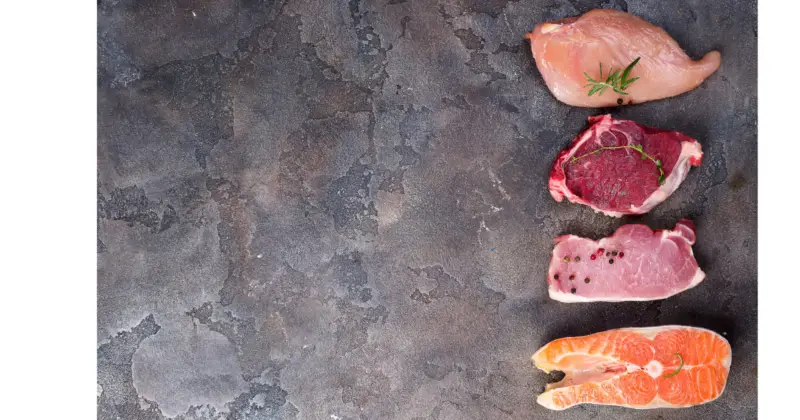
Feeding your pug raw meat can be vital to a raw food diet. Raw meat, such as beef or lamb, provides essential nutrients, vitamins, and minerals that contribute to your pug’s overall health. It’s important to understand which raw meats can be safely included in your dog’s diet and how to serve them properly.
When introducing raw meats into your pug’s diet, focus on muscle meat, an excellent protein and amino acid source. Include a variety of meats, such as beef, lamb, and poultry, to ensure a balance of nutrients. Be mindful of the quality and freshness of the meat you choose, as it can significantly impact their health.
In addition to muscle meat, incorporating raw meaty bones is essential for a well-rounded raw diet. These bones provide necessary calcium and other minerals, helping to support strong teeth and bones. When serving raw bones, be sure that they are soft enough to prevent damage to your pug’s teeth. Some examples of suitable raw meaty bones include chicken necks, wings, or small beef ribs.
However, Uncooked meat may contain harmful bacteria that can create digestive issues, so handling and storing meat safely is crucial. Always wash your hands and any utensils or surfaces that come into contact with the raw meat. Moreover, make sure to store the meat in a sealed container and keep it refrigerated or frozen until feeding time.
Introducing raw meat to your pug’s diet can seem challenging, but it’s easier than you may think. By focusing on providing a variety of high-quality muscle meat and raw meaty bones, you can ensure your pug enjoys a nutritious and well-balanced raw food diet.
Nutritional Value of Raw Meat

When considering feeding raw meat to your pug, it’s essential to understand its nutritional value. Raw meat is a rich source of protein which is vital for your dog’s overall health. Your pug’s muscles, skin, and fur will benefit from high-quality protein sources.
In addition to protein, raw meat contains healthy fat that is necessary for maintaining optimal energy levels in dogs. Fat is also crucial for the absorption of fat-soluble vitamins.
Regarding vitamins and minerals, raw meat is packed with essential nutrients that support your pug’s overall well-being. Vitamins are crucial in maintaining a healthy immune system, while minerals like calcium are essential for strong bones and teeth.
Raw meat also provides a variety of minerals like magnesium, which helps with nerve function and muscle contractions. It’s important to provide your pug with a balanced diet to ensure they are getting all the necessary nutrients.
To summarize, the nutritional benefits of feeding raw meat to your pug include:
- High-quality protein for muscle maintenance
- Healthy fats for energy and vitamin absorption
- Essential vitamins and minerals for overall health
- Calcium for strong bones and teeth
- Magnesium for nerve function and muscle contractions
While raw meat can offer these nutritional benefits, always consult your veterinarian before switching your pug’s diet to ensure it meets their specific needs.
Potential Risks of Feeding Raw Meat to Pugs

Feeding your pug raw meat can come with various risks, both to your pet and to you as the owner. Understanding these risks is important for making informed decisions about your pug’s diet.
One significant risk is the potential for bacterial contamination. Raw meat can harbor harmful bacteria, such as salmonella and E. coli, which can cause serious illness in both pugs and humans. If you handle contaminated raw meat and then come in contact with your pug or other household surfaces, you increase the risk of spreading these bacteria. To minimize the risk, always practice good hygiene and follow safe food handling guidelines when dealing with raw meat.
Your pug might also face choking hazards with raw meat. Although pugs can generally chew and digest raw meat, there is still the risk of choking, especially on small bones or large chunks. To minimize this risk, make sure to cut the meat into pieces appropriate to your pug’s size.
Veterinarians and organizations such as the American Veterinary Medical Association (AVMA) and Food and Drug Administration (FDA) advise against feeding raw meat diets to pets due to the potential risks. They recommend heat-treated products, which can help kill any harmful microorganisms present in the meat.
In conclusion, feeding your pug raw meat can pose several risks, including bacteria, choking hazards, and potential disagreement with veterinary experts. It is important to weigh these risks against any perceived benefits of a raw meat diet and consult with a veterinarian if you have any doubts about the best dietary choices for your pug.
Safe Handling and Preparation of Raw Meat
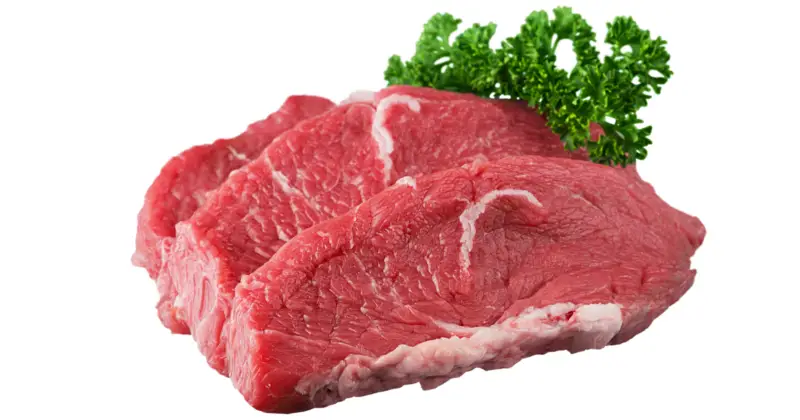
When feeding your pug raw meat, following safe handling and preparation practices is crucial to ensure both you and your pet stay healthy. Start by washing your hands with soap and warm water for at least 20 seconds before and after handling raw meat products source.
Choose a dedicated space for handling and preparing the raw meat, and keep other ingredients and utensils separate. This helps reduce the risk of cross-contamination. After working with the raw meat, clean the dedicated space thoroughly using warm water and soap.
It’s essential to monitor the quality of meat you are providing to your pug. Make sure to pick fresh, high-quality meat products from a trustworthy supplier. Store the raw meat in a refrigerated environment and ensure proper packaging to avoid exposure to air and potential contaminants.
There are two main approaches to raw feeding for pugs: Prey Model Raw (PMR) and the BARF diet source. Whichever you choose, providing balance and variety in your pug’s diet is important. This may include a mix of muscle meat, organ meat, and bones. Always consult a veterinarian or an expert in raw feeding for pugs to ensure your dog’s diet’s safety and nutritional balance.
Remember that safe handling and preparation of raw meat is paramount, not only for your pug’s health but also for your own. By following these guidelines and consulting with professionals, you can confidently provide a raw-meat-based diet that benefits your pug’s health in the long run.
Can Pugs Eat Raw Meat? Watch this
Including Fruits and Vegetables in a Pug’s Raw Diet
When you decide to feed your pug a raw diet, it is essential to include a variety of fruits and vegetables to ensure a balanced and nutritious meal. Your pug will benefit from the vitamins, minerals, and antioxidants that fruits and vegetables provide.
For instance, incorporating berries like blackberries into your pug’s diet can be beneficial as they are low in calories and sugar, and high in essential nutrients. You can offer fresh or frozen blackberries as a healthy snack for your pug.
In addition to berries, vegetables like carrots and broccoli are excellent choices for your pug’s raw diet. Carrots are rich in vitamin A and fiber, while broccoli provides essential vitamins and minerals like vitamin C, potassium, and calcium. Both can be offered raw or lightly steamed to retain their nutritional value.
As you introduce fruits and vegetables into your pug’s diet, monitoring their reaction and gradually increasing the amounts is crucial. Some fruits and vegetables can cause stomach upset or food intolerance in some dogs, so knowing your pug’s specific needs is essential.
By incorporating a variety of fruits and vegetables into your pug’s raw diet, you are providing them with the necessary nutrients for a healthy and balanced meal. Remember to monitor their reaction to new foods and adjust their diet accordingly to ensure optimal well-being.
Are Grains a Part of a Pug’s Raw Diet?

When considering a raw diet for your pug, grains may not be the first thing that comes to mind. However, it’s essential to understand the role of grains in a pug’s diet and how they can be incorporated into a raw feeding plan.
Grains are not a natural part of a dog’s ancestral diet, but they are often included in commercial dog food as an inexpensive source of energy. In a raw diet, the primary focus is on providing your pug with quality protein sources such as meat, bones, and organ meats. These foods make up the bulk of a pug’s nutritional requirements and are what nature intended for dogs to thrive on.
That being said, some pug owners introduce small grains into their dog’s raw diet for various reasons. One reason might be to incorporate additional fiber, which can help with digestion. When including grains, remember always to choose whole grains such as brown rice, quinoa, or oats, as these are more natural and healthier options compared to refined grains.
However, it’s important to note that not all pugs can tolerate grains. Some dogs may have allergies or sensitivities to certain grains, which can lead to digestive issues or other health problems. If your pug experiences any negative symptoms after the introduction of grains, it is recommended to remove them from the diet and consult your veterinarian for guidance. Furthermore, grain-free alternatives like sweet potatoes and pumpkin are available if you wish to include a high-fiber carbohydrate source in your pug’s raw diet.
In conclusion, while grains are not a necessary component of a pug’s raw diet, there are circumstances where some owners may decide to include them. Consider your dog’s needs and sensitivities before introducing grains, and consult with a professional if you’re unsure.
Dog Food Alternatives: Dry and Wet Foods
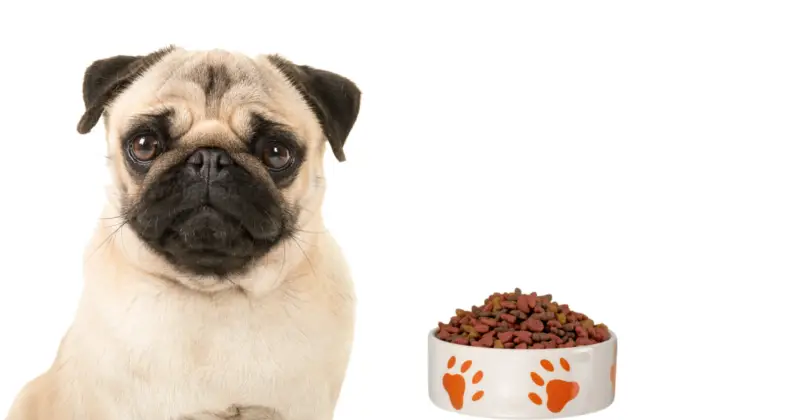
As a pug owner, you may consider feeding your furry friend a raw meat diet. However, there are other dog food alternatives that can provide your pug with the necessary nutrients for a healthy life. Let’s explore some options for both dry and wet dog foods.
Dry Dog Food: One popular option for pet owners is dry dog food, also known as kibble. Dry dog food is an affordable, convenient, and easy-to-store option. The crunchy texture of kibble can help keep your pug’s teeth clean by reducing the buildup of plaque and tartar. Some quality dry dog food brands offer well-balanced nutrition specifically designed for pugs, ensuring that your pet receives the essential vitamins and minerals needed for optimal health.
Wet Dog Food: If your pug prefers a more moist and flavorful meal, wet dog food is also an excellent choice. Wet dog food gives your dog a higher moisture content than dry kibble, which can benefit their overall hydration and help a pug’s sensitive stomach. Furthermore, wet dog food often contains fewer carbohydrates and more high-quality protein sources, which can help sustain your pug’s energy levels and support muscle health.
In conclusion, while a raw meat diet might seem appealing, various dry and wet dog food alternatives offer a similarly nutritious and balanced diet for your pug. Take the time to explore these options and choose the best one that meets your pug’s dietary needs and preferences.
Benefits of a Raw Food Diet for Pugs
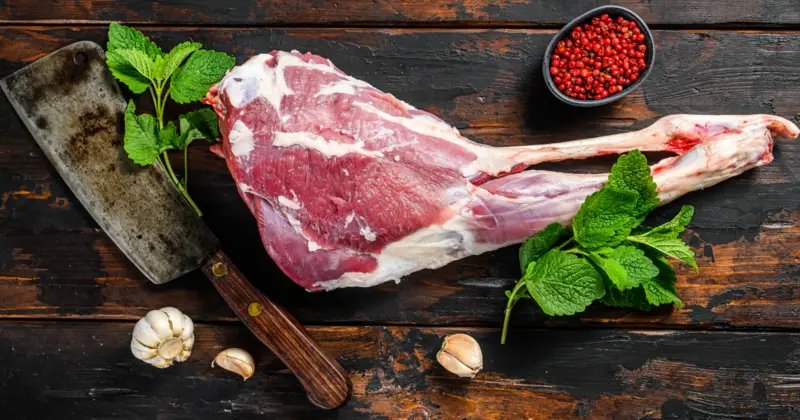
A raw food diet can provide several health advantages for your pug. One of the notable benefits is the improvement of your pug’s skin and coat. Feeding raw food can result in healthier skin and shinier coats, as it offers an abundance of essential nutrients and healthy fats. This diet can also reduce the likelihood of skin allergies or irritations related to processed commercial dog foods.
Likewise, raw diets contribute to cleaner teeth for your pug. Chewing and tearing at raw meaty bones can naturally clean their teeth and gums. This process effectively removes food particles and plaque, leading to fresher breath and reducing the risk of dental issues.
Another advantage of a raw food diet is that it can support your pug’s immune system. Providing a diet rich in proteins, essential vitamins, and minerals helps keep their immunity at its best, making them less prone to infections and diseases.
Feeding raw food to your pug can also result in smaller stools. Since the raw diet is biologically appropriate and easily digestible for pugs, their bodies can absorb most of the nutrients and produce less waste. Smaller stools mean easier cleanup and a healthier digestive system for your pet.
Switching to a raw food diet can offer various health benefits for your pug. It may require some adjustments and additional efforts, but it’s worth considering for your pug’s long-term well-being.
Conclusion: Can Pugs Eat Raw Meat

In summary, feeding your pug raw meat can be safe and even beneficial if done correctly. A well-balanced diet that includes raw meat can provide essential nutrients like muscle meat, heart, and gizzards, which are essential for your pug’s overall health. As a responsible pet owner, you must consider your pug’s individual needs and consult with a veterinarian before making any significant changes to their diet.
As with any dietary change, monitoring your pug’s health and adjusting accordingly is crucial. Handling raw meat safely is essential to prevent any bacterial contamination or potential health risks. Cleanliness and proper food storage can help you maintain a healthy diet for your pug while incorporating raw meat.
Furthermore, if you don’t feel confident about feeding your pug a completely raw diet, other dog food options can cater to their unique nutritional requirements. By discovering the best dietary choice for your pug, you can ensure they lead a happy, healthy, and fulfilling life as your beloved companion.
Frequently Asked Questions
Is it safe for pugs to consume raw meat?
Yes, it is safe for pugs to consume raw meat as long as it is properly handled and prepared. Many pug owners have had success with feeding their pugs raw diets. However, it is important to ensure that your pug receives a balanced and varied diet. Always consult your vet before making significant changes to your pet’s diet.
What types of raw meat can pugs eat?
Pugs can eat a variety of raw meats, including chicken, turkey, beef, lamb, and fish. It is essential to provide a variety of protein sources to ensure your pug receives all the necessary nutrients. Avoid feeding your pug high-fat meats, as pugs are prone to obesity.
How often should a pug be fed raw meat?
Raw meat can be fed as part of a pug’s daily diet. However, it is essential to balance raw meat with other nutrients, such as bones, organs, and vegetables, to support your pug’s overall health. Consult your pet’s veterinarian for specific guidelines on how often your pug should be fed raw meat.
What are the risks of feeding raw meat to pugs?
There are risks associated with feeding raw meat to pugs, such as bacterial contamination from harmful bacteria like Salmonella and E. coli[^(https://naomedical.com/blog/raw-diet-for-pugs-nao-medical/)]. Nutritional imbalances can also occur if your pug’s diet is not properly balanced. Always handle raw meat carefully and ensure that your pug receives a well-balanced diet.
Can raw meat have an impact on a pug’s behavior?
There isn’t sufficient evidence to suggest that raw meat has a direct impact on a pug’s behavior. However, a balanced and nutritious diet can support your pug’s overall health and well-being, which may indirectly influence their behavior.
Should I consider a raw diet for my pug?
If you’re considering a raw diet for your pug, it’s essential to understand both the benefits and risks involved[^(https://blackpugsite.com/can-pugs-eat-a-raw-diet/)]. A raw diet can be beneficial for some pugs, but it’s crucial to ensure that your pug receives all the necessary nutrients. Consult your pug’s veterinarian before making any significant changes to their diet.






